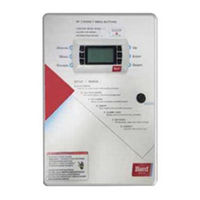Bard FUSION-TEC HR58APB Manuals
Manuals and User Guides for Bard FUSION-TEC HR58APB. We have 5 Bard FUSION-TEC HR58APB manuals available for free PDF download: Installation Support Materials, Service Instructions Manual, Installation Instructions Manual
Bard FUSION-TEC HR58APB Service Instructions Manual (47 pages)
WALL-MOUNT AIR CONDITIONER
Brand: Bard
|
Category: Air Conditioner
|
Size: 2 MB
Table of Contents
-
-
Operation
12-
Unit On/Off12
-
-
-
-
-
-
Compressor25
-
-
Test Mode26
-
-
Economizer28
-
-
Actuator28
-
Dust Sensor28
-
Damper Blade29
-
-
-
Maintenance
41 -
Advertisement
Bard FUSION-TEC HR58APB Installation Support Materials (53 pages)
Brand: Bard
|
Category: Racks & Stands
|
Size: 2 MB
Table of Contents
-
-
Operation
28-
-
Unit On/Off28
-
Mode32
-
-
-
Blower33
-
Filters34
-
Freezestat34
-
-
-
-
-
Compressor39
-
Economizer41
-
-
Actuator41
-
Damper Blade41
-
Dust Sensor41
-
-
-
Bard FUSION-TEC HR58APB Service Instructions Manual (32 pages)
WALL-MOUNT AIR CONDITIONER Part of the Bard Free Cooling Unit System
Brand: Bard
|
Category: Air Conditioner
|
Size: 2 MB
Table of Contents
-
-
-
-
-
-
-
Compressor21
-
Economizer23
-
-
Actuator23
-
Dust Sensor23
-
Damper Blade24
-
-
-
Maintenance
32
Advertisement
Bard FUSION-TEC HR58APB Service Instructions Manual (33 pages)
WALL-MOUNT AIR CONDITIONER
Brand: Bard
|
Category: Air Conditioner
|
Size: 2 MB
Table of Contents
-
Cooling10
-
Heating11
-
Staging11
-
Blower14
-
Filters16
-
Freezestat18
-
Compressor22
-
Economizer24
-
Actuator24
-
Dust Sensor24
-
Damper Blade25
-
General31
Bard FUSION-TEC HR58APB Installation Instructions Manual (41 pages)
Brand: Bard
|
Category: Air Conditioner
|
Size: 2 MB
Table of Contents
Advertisement




